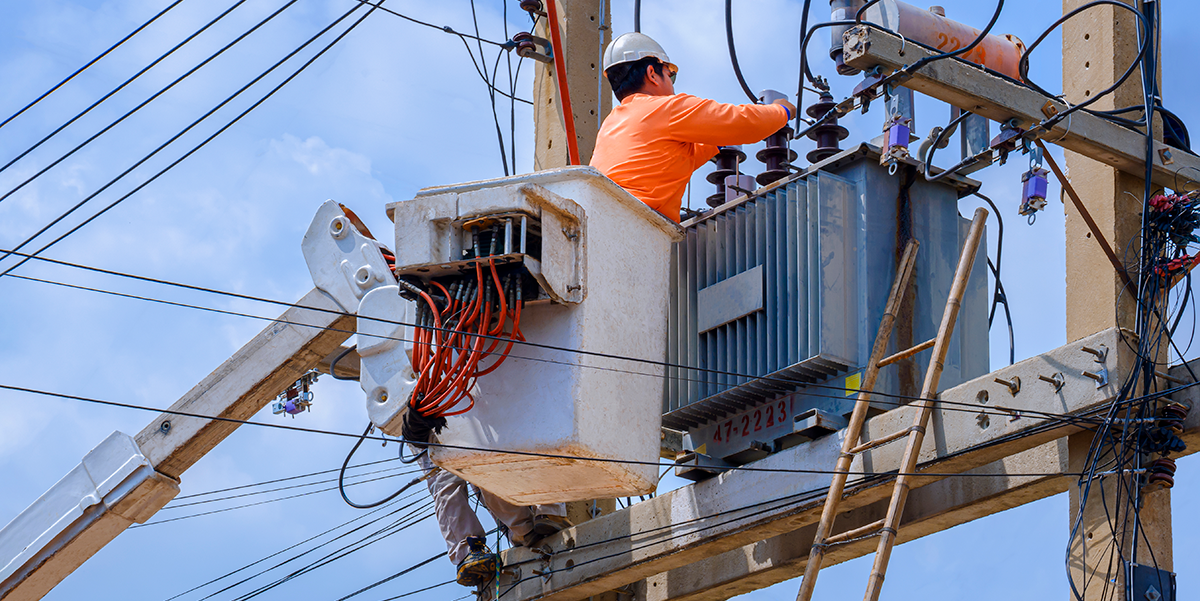The Risks Utility Workers Face and the Critical Need for Intrinsically Safe Solutions

Working in the utilities sector can be hazardous. Workers face various risks, including heat stress, fatigue, noise exposure, chemical hazards and dangers in confined spaces. These risks can lead to severe injuries or even fatalities. Ensuring worker safety is crucial, especially in environments where explosive atmospheres can occur. This is where intrinsically safe solutions become indispensable. In this article, we will explore the specific risks utility workers face, the importance of intrinsically safe solutions and how smart safety solutions can help address these challenges.
What does a utility worker do?
Utility workers maintain and repair the essential services that keep our communities running. They work on systems such as water, gas, electricity and sewage. Their job involves installing new equipment, performing routine maintenance and responding to emergencies. Whether they are fixing a broken water main or ensuring the electricity flows smoothly, utility workers play a crucial role in our daily lives. They often work in different environments, from underground tunnels to high up on utility poles. This diverse and challenging field requires a combination of technical skills, physical strength and a commitment to safety.
What are the risks in the utilities sector?
Utility workers encounter numerous hazards daily. If not managed correctly, these risks can lead to severe injuries or even fatalities. Here are some of the hazards and solutions below.
Heat stress
Heat stress occurs when the body cannot cool itself adequately, leading to dizziness, nausea and heat stroke. Utility workers often work in hot environments, increasing their risk. According to the Occupational Safety and Health Administration (OSHA), heat stress affects thousands of workers annually, particularly those in physically demanding jobs.
In 2020, the U.S. Bureau of Labor Statistics (BLS) reported 1,940 cases of injuries or illnesses due to environmental heat exposure in the private sector, as well as 390 cases in state and local government. These cases resulted in affected workers taking an average of two days off work. The trade, transportation and utilities sector within the private industry had the highest number of reported heat-related injury cases, with 440 incidents.
– Example: A lineman working on electrical repairs in sweltering summer heat can quickly succumb to heat stress without adequate hydration and rest. This can lead to life-threatening conditions if not promptly addressed.
– Solution: Employers can mitigate these risks by providing cooling vests, ensuring access to water and scheduling regular breaks. Additionally, they can implement monitoring solutions such as using wearables like those from Bodytrak®, which monitor ambient temperatures and track vital signs to prevent heat stress.
Fatigue
A survey from the National Safety Council revealed that 69% of employees, some in safety-critical industries, experience fatigue at work. Fatigue reduces a worker’s ability to perform tasks safely, leading to mistakes and accidents. The Centers for Disease Control and Prevention (CDC) states that fatigue-related incidents are a significant concern in industries requiring long hours and shift work. In utilities, fatigue can result from long hours in challenging conditions, affecting safety and productivity.
– Example: A technician working extended hours to restore power after a storm may experience severe fatigue, increasing the likelihood of errors. This can lead to accidents, such as falls or equipment mishandling, posing severe safety risks.
– Solution: Implementing shift rotations and ensuring proper rest periods can help mitigate fatigue-related risks.
Noise exposure
Prolonged exposure to loud noises can cause hearing loss and other health issues. Utility workers often use heavy machinery, leading to high noise levels. The National Institute for Occupational Safety and Health (NIOSH) reports that about 22 million workers are exposed to potentially damaging noise yearly.
In addition, the National Library of Medicine discovered that noise levels in electric plants typically surpass 85 dB(A), exceeding OSHA’s safe noise exposure limits. Specifically, the study found that the average noise level in three gas-fired electric plants was 91.3 dB(A).
– Example: Workers maintaining large turbines at a power plant are constantly exposed to high noise levels, risking long-term hearing damage if not adequately protected.
– Solution: Providing high-quality hearing protection and conducting regular noise level assessments can help safeguard workers’ hearing.
Chemical exposure
Utility workers may handle hazardous chemicals, risking exposure to harmful substances. This can cause acute injuries or long-term health problems. The US Environmental Protection Agency highlights numerous incidents where chemical exposure has led to severe health issues and fatalities.
Additionally, in 2023, Linewatch, a prominent pipeline safety awareness organization, reported that nearly two in five (19%) workers who were digging dangerously close to underground high-pressure oil, gas and chemical pipelines were engaged in utility work.
– Example: A worker handling chlorine in a water treatment plant could suffer from respiratory issues or chemical burns if exposed due to a spill or leak.
– Solution: Ensuring proper storage and handling procedures, and using personal protective equipment, can significantly reduce these risks.
Confined spaces
Working in confined spaces, such as tanks or sewers, poses unique dangers. These areas may have poor ventilation, leading to hazardous atmospheres. Other dangers may include flooding, drowning or asphyxiation from other sources such as dust, grain or other contaminants. According to the U.S. BLS, confined space incidents result in numerous injuries and deaths each year.
In 2020, trench collapses led to the deaths of 168 workers, underscoring that trenches can also be classified as confined spaces. BLS reports that manholes and vaults are the third-leading locations for confined space fatalities. The primary causes of these deaths are naturally occurring hydrogen sulfide, carbon monoxide and methane.
– Example: A maintenance worker entering a sewer system might encounter dangerous gasses such as methane or hydrogen sulfide, posing severe health risks.
– Solution: Using gas detectors and ensuring proper ventilation can prevent such incidents. Additionally, training workers on confined space entry procedures is crucial.
Having explored the various dangers that utility workers encounter, it becomes clear why there’s a pressing need for effective safety measures. However, one area organizations may not consider is the importance of intrinsically safe solutions in the utilities sector.
The critical need for intrinsically safe solutions
Utility workers operate in environments where safety hazards are ever-present. This section delves into the critical need for intrinsically safe solutions, ensuring workers are protected in the most hazardous conditions.
Solutions that are intrinsically safe ensure that electrical equipment operates at energy levels low enough to prevent ignition in explosive atmospheres. This principle is crucial for preventing fires and explosions in industries where workers are exposed to flammable gasses, vapors and dust.
- Low energy levels: Devices are engineered to ensure that, even in fault conditions, the energy released is insufficient to ignite hazardous substances.
- Fail-safe design: Intrinsically safe equipment is designed to prevent ignition during regular operation and potential malfunctions, making it highly reliable in dangerous settings.
Consider a utility worker using a gas detector in a confined space. Without intrinsic safety, a spark from the device could ignite gas vapors, causing an explosion. Intrinsically safe designs prevent such incidents, ensuring worker safety.
Why intrinsically safe solutions are vital in utilities
Utility workers face high risks due to explosive atmospheres caused by gasses, vapors and dust. Equipment that is intrinsically safe is crucial to mitigate these risks. Potential ignition sources include electrical equipment and tools, which can easily trigger explosions if not properly managed.
High-risk environments
Gas distribution networks, wastewater treatment plants and electrical substations are just a few examples where explosive atmospheres are common.
Preventing catastrophes
Intrinsically safe equipment helps avoid incidents that could lead to extensive property damage, environmental harm and loss of life.
An explosion in a gas distribution network could have devastating consequences. By using intrinsically safe equipment, workers can safely monitor gas levels and perform maintenance tasks without the risk of igniting flammable gasses.
Regulations and standards
Compliance with stringent safety standards is essential to ensure worker safety in hazardous environments. Key regulations, such as ATEX in Europe, IECEx worldwide and NEC in the US, set the framework for intrinsically safe equipment.
- ATEX (Europe): This directive outlines the safety requirements for equipment used in explosive atmospheres. It ensures that devices are designed to prevent ignition risks, which is crucial for European utility workers.
- IECEx (Worldwide): The International Electrotechnical Commission’s certification provides a global benchmark for safety and facilitates international trade in safe equipment.
- NEC (US): The National Electrical Code specifies the classification and installation standards for electrical equipment in hazardous locations, ensuring the protection of utility workers in the US.
For instance, a wastewater treatment plant in the US uses equipment compliant with NEC standards to monitor and control methane levels. This compliance prevents potential explosions and ensures the safety of workers and the surrounding community.
The first step is recognising the critical need for intrinsically safe solutions. Next, let’s explore how smart safety solutions specifically address these needs through innovative products designed to protect utility workers in the most hazardous conditions.
How an intrinsically safe wearable can enhance safety for utility workers
Bodytrak is committed to elevating workplace safety through advanced technology. Bodytrak 1 IS is an intrinsically safe solution that consists of a non-invasive in-ear device that monitors core body temperature (CBT), heart rate, noise exposure, and more, to prevent incidents through actionable data. As one of the very few wearables on the market that is compliant with ATEX and IECEx standards for intrinsic safety, Bodytrak is designed for use in hazardous environments typical of the utility sector. By leveraging real-time data analytics and alerts, Bodytrak enables proactive safety management, providing instant alerts to both workers and supervisors when a worker is at risk.
Applications in utilities
- Real-time heat stress monitoring: The smart safety solution from Bodytrak monitors workers’ CBT, providing crucial and accurate data for preventing heat-related incidents. During a summer heatwave, for instance, Bodytrak can alert a lineman working on power lines when their CBT begins to reach levels that can put them at risk. This acts as a prompt for the worker to take a break in order to cool down before leading to more serious symptoms. At the same time, supervisors also receive the same information so that they can check action is being taken, ensuring timely intervention and reducing the risk of heat-related illnesses.
- Fatigue management: Fatigue is a common issue for utility workers, especially during emergency repairs after natural disasters. Bodytrak monitors heart rate variability to offer insights into workers’ fatigue levels, helping supervisors schedule breaks effectively. This capability is vital during extended power outage repairs, where overexertion can lead to mistakes and accidents.
- Noise metering: Workers in utilities are frequently exposed to high levels of noise from heavy machinery and equipment. Bodytrak measures noise exposure, ensuring compliance with safety standards and protecting workers’ hearing. For example, Bodytrak can identify areas with excessive noise in a power plant, enabling targeted interventions such as providing additional hearing protection or implementing noise control measures.
- Safety in confined spaces: Bodytrak’s geolocation and geofencing capabilities ensure worker safety in confined spaces by providing precise location data and alerts. This feature is critical for sewer maintenance crews, where knowing the exact location of a worker can expedite rescue efforts during emergencies involving dangerous gasses such as methane or hydrogen sulfide.
Utility workers face significant risks, including heat stress, fatigue, noise exposure, chemical hazards and confined spaces. The intrinsically safe solution from Bodytrak is essential to preventing incidents and ensuring worker safety. By integrating Bodytrak into their safety programmes, companies can enhance compliance, reduce costs and improve overall safety and productivity.
Don’t wait to protect your workforce – explore how Bodytrak can elevate your safety standards today.




